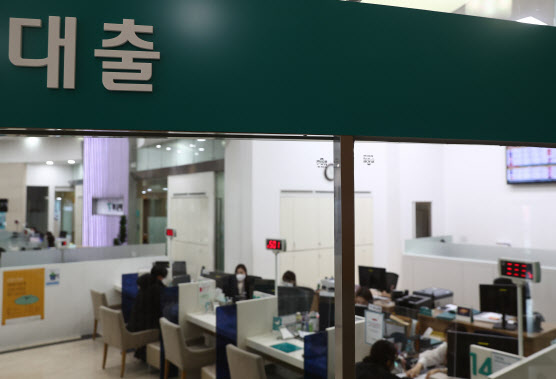|
[이데일리 장순원 기자] Banknote lending rates are on the rise. Until now, if the effects of regulatory side effects have been large, concerns arise that the interest burden may increase as market interest rates rise in the future.
Regulatory headwinds, interest burdens that have surged since the end of last year
According to the financial sector on the 23rd, the interest rates of KB Kookmin, Shinhan, Woori, Hana and NH Nonghyup Bank’s flagship credit loan products ranged from 2.19 to 4.7%. It is estimated that interest rates of 3-4% will be applied based on grades 1-3.
The interest rate on credit loans for banking sectors has risen sharply starting in the second half of last year. According to the Bank of Korea, as of the end of last year, the rate of general credit loans for banknotes was set at 3.5%. It jumped 0.49 percentage points compared to a month ago. Compared to the end of August last year (2.86%), it has increased by 0.64 percentage points.
The interest rate on bank bonds (one-year bonds), which is the standard for banknote credit loans, has declined from 0.881% to 0.855% (as of February 16) over the same period. The COPIX (based on new balance) that the Bank Federation of Korea collects also fell from 1.07% to 0.9%. Looking at the interest rate environment alone, there is no reason for the loan interest rate to rise, but it was a reverse run.
In the banking sector, it is estimated that government regulations have raised the interest rate on credit loans. Since the end of last year, the financial authorities have come up with strong lending deterrence measures as household loans have risen sharply as the demand for debt-to-debt (investment from debt) and lingering loans (which draws to the soul) has increased. Banks that failed to meet the target after reapplying the total amount regulation of around 2 trillion won per month issued a drastic prescription to lower their lending target.
Banknotes that have fallen on their feet are adjusting demand by lowering the limit or raising the interest rate on loans. The interest rate of the banknote is determined by adding the additional interest rate to the base rate and subtracting the preferential interest rate. It is difficult for banks to freely adjust the standard interest rate that follows the market interest rate or the additional interest rate that is subject to strict requirements, so they mainly use a method of raising the loan interest rate by significantly reducing the preferential interest rate. In fact, one of the five largest banks has lowered the maximum preferential interest rate from 0.8% to 0.3%. In fact, it is the same effect as raising the loan interest rate by 0.5 percentage points. Government regulation is expected to continue for the time being. The banking sector is keen on the’advanced household debt management plan’ to be announced next month. The key is to convert the subject of the total debt principal repayment ratio (DSR) from existing financial institutions to borrowers. There is also a plan to make it mandatory to pay in installments for customer credit loans over a certain amount.
Counterattack of releasing money… The burden of variable interest rates increases
If the rising interest rate so far has been a regulatory headwind, the market is waiting for a counterattack. This is because bond yields are rising, centering on long-term bonds, as the world is confronting Corona 19 with money loosening, increasing inflation (inflation) pressure. The US 10-year Treasury bond yield rose to 1.39% at one time on the 22nd (local time), approaching 1.4%. If the U.S. Treasury yield rises further, the pressure on interest rates to rise in Korea could also increase. The interest rate of Korean government bonds is also rising. 10-year government bonds exceeded 1.9% per year. It is the highest in almost two years.
If the government bond yield, which is the standard for the bond market, rises, the interest rates of other bonds, including bank bonds, naturally rise. If the interest rate on bank bonds, which is directly linked to the loan rate, jumps, it is directly linked to a loan rate hike.
The mixed-type (fixed) mortgage loan interest rate, which has already followed the movement of long-term bond rates, has risen 0.5 percentage points in the last six months. KB Kookmin Bank’s maximum interest rate for hybrid products, which has a large share of the main charge, exceeded the 4% range. In the case of variable interest rates that reflect fluctuations in market interest rates, the burden can also increase. Domestic banking household loans increased by 10 trillion won last year alone, reaching 1,000 trillion won. About 70% of bank household loans are variable-rate products, which could be hit directly by rising interest rates.
Lee Dae-gi, a senior researcher at the Korea Finance Research Institute, said, “I borrowed money easily as the low interest rate continued, but the burden will inevitably increase, so it is necessary to respond to reducing the size of the debt.” You have to keep the part where you want to keep the goal.”

